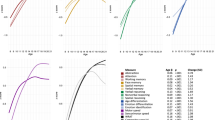Abstract
The basic methodology of behavior genetics is described in the context of the twin and sibling/adoption design. Results of applying this model to cross-sectional data on cognitive development throughout the lifespan are presented. Results from a large longitudinal twin and adoption study of general intelligence are presented to illustrate the use of the basic behavior genetic model in studying the causes of continuity and change in development. A special model is presented for the study of abnormal behavior occurring at the extremes of the distribution and an adaptation of the model is discussed for the study of genetic linkage or the mapping of quantitative trait loci (QTL). Results of applying this model to a sample of twins and kindred siblings indicated the presence of a major QTL for dyslexia on chromosome 6. The purpose of the paper is to illustrate the scope of behavior genetic methodology in studying individual differences in behavior in a biosocial context.
Similar content being viewed by others
References
Bayley, N. (1969).Manual for the Bayley scales of infant development. New York: Psychological Corporation.
Benson, J.B., Cherny, S.S., Haith, M.M. & Fulker, D.W. (1993). Rapid assessment of infant predictors of adult IQ: Midtwin-midparent analyses,Developmental Psychology 29: 434–447.
Bouchard Jr., T.J. & McGue, M. (1981). Familial studies of intelligence: A review,Science 212: 1055–1059.
Cardon, L.R., Corley, R.P., DeFries, J.C., Plomin, R. & Fulker, D.W. (1992). Factorial validation of a telephone test battery of specific cognitive abilities,Personality and Individual Differences 13: 1047–1050.
Cardon, L.R. & Fulker, D.W. (1994). The power of interval mapping of quantitative trait loci, using selected sib pairs,American Journal of Human Genetics 55: 825–833.
Cherny, S.S., Fulker, D.W. & Hewitt, J.K. (1995). Cognitive development from infancy to middle childhood, in: R.J. Sternberg & E.L. Grigorenko (eds.),Intelligence: Heredity and environment. Cambridge: Cambridge University Press.
DeFries, J.C. & Gillis, J.J. (1991). Etiology of reading deficits in learning disabilities: Quantitative genetic analysis, pp. 29–47 in: J.E. Obrzut & G.W. Hyndm (eds.),Neuropsychological Foundations of Learning Disabilities. Orlando, FL: Academic Press.
DeFries, J.C., Plomin, R. & Fulker, D.W. (1994).Nature and nurture during middle childhood. Cambridge, MA: Blackwell.
DeFries, J.C., Vandenberg, S.G., McClearn, G.E., Kuse, A.R. & Wilson, J.R. (1974). Near identity of cognitive structure in two ethnic groups,Science 183: 338–339.
DiLalla, L.F., Thompson, L.A., Plomin, R., Phillips, K., Fagan III, J.F., Haith, M.M., Cyphers, L.H. & Fulker, D.W. (1990). Infant predictors of preschool and adult IQ: A study of infant twins and their parents,Developmental Psychology 26: 759–769.
Eaves, L.J., Long, J. & Heath, A.C. (1986). A theory of developmental change in quantitative phenotypes applied to cognitive development,Behavior Genetics 16;:143–162.
Emde, R.N., Plomin, R., Robinson, J., Reznick, J.S., Campos, J., Corley, R., DeFries, J.C., Fulker, D.W., Kagan, J. & Zahn-Waxler, C. (1992). Temperament, emotion, and cognition at 14 months: The MacArthur Longitudinal Twin Study,Child Development 63: 1437–1455.
Fulker, D.W. & Cardon, L.R. (1994). A sib-pair approach to interval mapping of quantitative trait loci,American Journal of Human Genetics 55: 1092–1103.
Fulker, D.W., Cardon, L.R., DeFries, J.C., Kimberling, W.J., Pennington, B.F. & Smith, S.D. (1991). Multiple regression analysis of sib-pair data on reading to detect quantitative trait loci,Reading and Writing: An Interdisciplinary Journal 3: 299–313.
Fulker, D.W., Cherny, S.S. & Cardon, L.R. (1995). Multipoint interval mapping of quantitative trait loci using sib pairs,American Journal of Human Genetics 56: 1224–1233.
Haseman, J.K. & Elston, R.C. (1972). The investigation of linkage between a quantitative trait and a marker locus,Behavior Genetics 2: 3–19.
Humphreys, L.G. & Davey, T.C. (1988). Continuity in intellectual growth from 12 months to 9 years,Intelligence 12: 183–197.
Jinks, J.L. & Fulker, D.W. (1970). Comparison of the biometrical genetical, MAVA, and classical approaches to the analysis of human behavior,Psychological Bulletin 73: 311–349.
Kent, J. & Plomin, R. (1987). Testing specific cognitive abilities by telephone and mail,Intelligence 11: 391–400.
McGue, M., Bouchard Jr., T.J., Iacono, W.G., & Lykken, D.T. (1993). Behavioral genetics of cognitive ability: A life-span approach, pp. 59–76 in: R. Plomin & G.E. McClearn (eds.),Nature, nurture and psychology. Washington, DC: American Psychological Association.
Neale, M.C. & Cardon, L.R. (1992).Methodology for genetic studies of twins and families. Dordrecht: Kluwer Academic Press.
Plomin, R., Campos, J., Corley, R., Emde, R.N., Fulker, D.W., Kagan, J., Reznick, J.S., Robinson, J., Zahn-Waxler, C. & DeFries, J.C. (1990a). Individual differences during the second year of life: The MacArthur Longitudinal Twin Study, pp. 431–455 in: J. Columbo & J. Fagan (eds.),Individual differences in infancy: Reliability, stability, and predictability. Hillsdale, NJ: Lawrence Erlbaum Associates.
Plomin, R. & DeFries, J.C. (1985).Origins of individual differences in infancy: The Colorado adoption project. Orlando, FL: Academic Press.
Plomin, R., DeFries, J.C., & Fulker, D.W. (1988).Nature and nurture in infancy and early childhood. Cambridge: Cambridge University Press.
Plomin, R., DeFries, J.C., & McClearn, G.E. (1990b).Behavioral genetic.s: A primer, 2nd ed. New York: Freeman.
Plomin, R., Emde, R.N., Braungart, J.M., Campos, J., Corley, R., Fulker, D.W., Kagan, J., Reznick, J.S., Robinson, J., Zahn-Waxler, C. & DeFries, J.C. (1993). Genetic change and continuity from fourteen to twenty months: The Macarthur longitudinal twin study,Child Development 64: 1354–1376.
Terman, L.H. & Merrill, M.A. (1973).Stanford-Binet intelligence scale: 1972 norms edition. Boston: Houghton-Mifflin.
Wechsler, D. (1974).Manual for the Wechsler intelligence scale for children — revised. New York: Psychological Corporation.
Young, S.E., Schmitz, S., Corley, R.P. & Fulker, D.W. (1995). Expressive and receptive language development in twins (in preparation).
Author information
Authors and Affiliations
Corresponding author
Rights and permissions
About this article
Cite this article
Fulker, D.W., Cherny, S.S. Genetic and environmental influences on cognition during childhood. Popul Res Policy Rev 14, 283–300 (1995). https://doi.org/10.1007/BF01074393
Issue Date:
DOI: https://doi.org/10.1007/BF01074393




